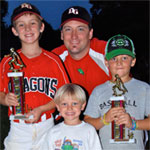Hitting Fundamentals
Hitting a baseball is one of the most complex body actions in sport. It requires total body synchronicity, precise eye-hand coordination, balance, timing, rhythm, and strength. When practicing, especially at the younger levels, try and incorporate some form of coordination exercises at every practice. The better your kids can become at controlling their bodies, the better baseball players they will be. Examples: skipping rope, one leg balancing, simple jumps, target practice, switch hitting, juggling, one handed catches, etc. One last note, as kids get older, pay special attention to their flexibility and range of motion in their joints.
Stance
- Grip
- Lay bat at base of fingers and close.
- Feet
- Pointing straight ahead (into opposite batter’s box).
- A little further than shoulder width apart.
- Weight on balls of feet.
- Posture
- Knees slightly bent.
- Waist slightly bent.
- Hands
- At or near the back shoulder at shoulder height.
- Not too close to body, not too far away.
- Hands above elbows.
- Shoulders
- Level or back shoulder slightly higher than front shoulder.
- Bat
- At 45-degree angle right over rear shoulder and knob pointed slightly back at catcher.
- Weight
- Evenly distributed or slightly on back leg.
- Head
- Straight up with both eyes on pitcher.
Pre-Swing Approach (Stride)
- Weight Load
- Weight gently rocks into backside, keeping rear knee inside rear foot.
- Can be done by gently turning in front knee or front shoulder.
- Both eyes remain on pitcher.
- Stride
- Stride foot remains parallel with back foot or slightly open, straight back at pitcher.
- Point front hip and shoulder at pitcher.
- Hand Load
- As stride begins, hands move up and back away from pitcher slightly.
- Toe Touch (Stride Landing)
- As stride foot lands, weight is evenly distributed between the feet (balanced).
- Hands slightly behind rear shoulder at shoulder height (separation).
- Bat at 45-degree angle with barrel angled behind head.
Toe Touch
Toe touch is one the most critical parts of the swing. Many hitters’ will vary in their stance, but at toe touch they are virtually all in the same position. This is the time where you make your decision to swing or take the pitch. Make sure you are in a strong hitting position when the stride foot lands.
Swing/Swing Plane
Everything we have talked about up to this point can be taught, practiced and controlled. The swing is strictly the hitters reaction to the pitch and one of the hardest things to refine. Not only because each hitters’ swing may be different due to their mechanics, maturity, coordination and strength, but the pitch location and speed will dictate how the hitter will react.
- Hips
- Rear hip initiates swing.
- Hands
- Hands are right behind the hips.
- Go straight to projected path of the pitch.
- Front leg
- Straightens out forming rotational point.
- Body Position
- Body is positioned between feet.
- Back hip
- Drives to contact.
- Point of Contact
- Palm up, palm down.
- Arms not fully extended.
- Head down at contact.
- Full extension
- Full arm extension after contact.
- Full hip turn
- Hips should be perpendicular to pitcher at finish.
- Rear Foot
- Fully rotated and in line with pitcher.
- Rear heel off the ground.
- Full shoulder turn
- Rear shoulder should be close to pointing at pitcher.
- Finish
- Balanced
- Hands at or near front shoulder
Teaching Points
The hitter needs to control everything that he can control. He can control his stance. His approach. And most of the time his follow through. Create good habits.
Stance
- Make sure stance is correct-check grip, feet, alignment, hands, posture, head, weight distribution.
Approach
- Prepare for pitch out over the plate, react in.
- Watch stride location, direction of feet.
- Purposely throw pitches out of the strike zone or fake throw to ensure hitter is getting to proper spot during approach.
- Make sure hitter takes pitch in strong hitting position (balanced with hands up and back).
- Make sure front foot is down before swing begins.
- Watch bobbing of the head up and down/side to side.
- Watch for excessive barrel waving as hitter begins swing.
Swing
- Pay attention to swing plane (barrel path) and where hands/barrel start and finish.
- Pay attention to how the ball comes off the bat.
- Make sure hitter gets a good follow through with hips (rear hip).
- Make sure hitter gets good follow through with shoulders (rear shoulder).
- Watch balance.
Baseball Zone’s Memberships give you access to more information on the fundamentals of hitting, troubleshooting hitter problems as well as tons of information on pitching, defense and training.
Baseball Zone’s Practice Planner makes creating practice plans quick and easy. With over a hundred different drills to choose from, creating a well thought out plan is only a few clicks away.

